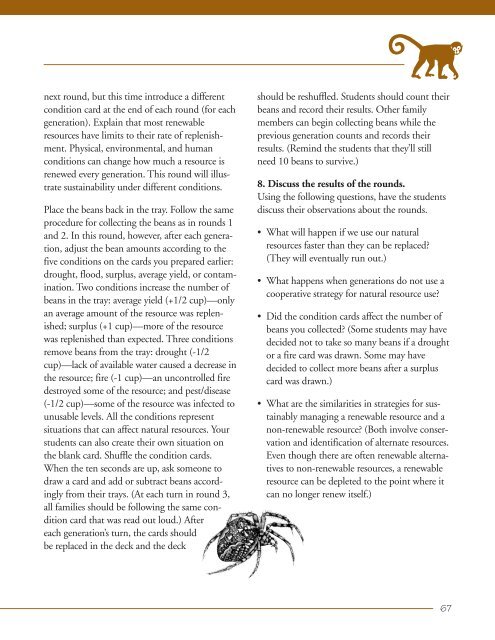EXPLORING BIODIVERSITY: A Guide for Educators Around the World
EXPLORING BIODIVERSITY: A Guide for Educators Around the World
EXPLORING BIODIVERSITY: A Guide for Educators Around the World
Create successful ePaper yourself
Turn your PDF publications into a flip-book with our unique Google optimized e-Paper software.
a<br />
next round, but this time introduce a different<br />
condition card at <strong>the</strong> end of each round (<strong>for</strong> each<br />
generation). Explain that most renewable<br />
resources have limits to <strong>the</strong>ir rate of replenishment.<br />
Physical, environmental, and human<br />
conditions can change how much a resource is<br />
renewed every generation. This round will illustrate<br />
sustainability under different conditions.<br />
Place <strong>the</strong> beans back in <strong>the</strong> tray. Follow <strong>the</strong> same<br />
procedure <strong>for</strong> collecting <strong>the</strong> beans as in rounds 1<br />
and 2. In this round, however, after each generation,<br />
adjust <strong>the</strong> bean amounts according to <strong>the</strong><br />
five conditions on <strong>the</strong> cards you prepared earlier:<br />
drought, flood, surplus, average yield, or contamination.<br />
Two conditions increase <strong>the</strong> number of<br />
beans in <strong>the</strong> tray: average yield (+1/2 cup)—only<br />
an average amount of <strong>the</strong> resource was replenished;<br />
surplus (+1 cup)—more of <strong>the</strong> resource<br />
was replenished than expected. Three conditions<br />
remove beans from <strong>the</strong> tray: drought (-1/2<br />
cup)—lack of available water caused a decrease in<br />
<strong>the</strong> resource; fire (-1 cup)—an uncontrolled fire<br />
destroyed some of <strong>the</strong> resource; and pest/disease<br />
(-1/2 cup)—some of <strong>the</strong> resource was infected to<br />
unusable levels. All <strong>the</strong> conditions represent<br />
situations that can affect natural resources. Your<br />
students can also create <strong>the</strong>ir own situation on<br />
<strong>the</strong> blank card. Shuffle <strong>the</strong> condition cards.<br />
When <strong>the</strong> ten seconds are up, ask someone to<br />
draw a card and add or subtract beans accordingly<br />
from <strong>the</strong>ir trays. (At each turn in round 3,<br />
all families should be following <strong>the</strong> same condition<br />
card that was read out loud.) After<br />
each generation’s turn, <strong>the</strong> cards should<br />
be replaced in <strong>the</strong> deck and <strong>the</strong> deck<br />
should be reshuffled. Students should count <strong>the</strong>ir<br />
beans and record <strong>the</strong>ir results. O<strong>the</strong>r family<br />
members can begin collecting beans while <strong>the</strong><br />
previous generation counts and records <strong>the</strong>ir<br />
results. (Remind <strong>the</strong> students that <strong>the</strong>y’ll still<br />
need 10 beans to survive.)<br />
8. Discuss <strong>the</strong> results of <strong>the</strong> rounds.<br />
Using <strong>the</strong> following questions, have <strong>the</strong> students<br />
discuss <strong>the</strong>ir observations about <strong>the</strong> rounds.<br />
• What will happen if we use our natural<br />
resources faster than <strong>the</strong>y can be replaced?<br />
(They will eventually run out.)<br />
• What happens when generations do not use a<br />
cooperative strategy <strong>for</strong> natural resource use?<br />
• Did <strong>the</strong> condition cards affect <strong>the</strong> number of<br />
beans you collected? (Some students may have<br />
decided not to take so many beans if a drought<br />
or a fire card was drawn. Some may have<br />
decided to collect more beans after a surplus<br />
card was drawn.)<br />
• What are <strong>the</strong> similarities in strategies <strong>for</strong> sustainably<br />
managing a renewable resource and a<br />
non-renewable resource? (Both involve conservation<br />
and identification of alternate resources.<br />
Even though <strong>the</strong>re are often renewable alternatives<br />
to non-renewable resources, a renewable<br />
resource can be depleted to <strong>the</strong> point where it<br />
can no longer renew itself.)<br />
67

















